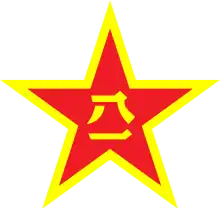Chinese military operations other than war (MOOTW) focus on deterring war, resolving conflict, promoting peace, and supporting civil authorities in response to domestic crises.
The non-traditional missions of the Chinese armed forces have evolved as an increasingly used tool of statecraft.[1] China has deployed forces in more than a dozen UN peacekeeping missions, and has committed over 3,000 personnel to UN peacekeeping operations.[2][3]
The People's Liberation Army (PLA) established specialized forces for military operations other than war. Current planning anticipates five specialized groups, including (a) flood and disaster relief forces, (b) post-earthquake emergency rescue forces, (c) emergency rescue forces for nuclear, chemical and biological disasters, (d) emergency relief force for transportation facilities and (e) international peacekeeping force.[4]
MOOTW have been a subject of study at the National Defense University (NDU), which became a venue for examining the practical experience of equipment utilization and support. The characteristics, rules, contents and methods of equipment utilization and support in MOOTW were evaluated.[5]
Select Chinese deployments
- Somali pirates, 2009: Naval escort missions in waters off Somalia.[6]
See also
References
Citations
- ↑ Watson, Cynthia. "The Chinese Armed Forces and Non-Traditional Missions: A Growing Tool of Statecraft," China Brief, Vol. 9, No. 4, February 20, 2009.
- ↑ "Is China contributing to the United Nations' mission?". CSIS China Power. 7 March 2016.
- ↑ Ling, Bonny. "China's Peacekeeping Diplomacy," Archived 2009-07-29 at the Wayback Machine China Rights Forum. No. 1, 2007.
- ↑ "PLA Constructs MOOTW Arms Force System," People's Liberation Army Daily. May 24, 2009.
- ↑ Wu Yulin and Liu Demao. "Academic symposium on MOOTW equipment utilization and support held in NDU," People's Liberation Army Daily. 2009-January 9, 2009.
- ↑ Chin Jie. "Naval flotilla for escort mission in waters off Somalia, Gulf of Aden returns," Xinhua. August 21, 2009.
Sources
- Hellström, Jerker. "Blue Berets under the Red Flag: China in the UN Peacekeeping System", Swedish Defence Research Agency (FOI) 2009
- Ling, Bonny. "China's Peacekeeping Diplomacy," China Rights Forum. No. 1, 2007.
- Ministry of National Defense of the People's Republic of China: Military operations other than war; China's Participation in UN Peacekeeping Operations
